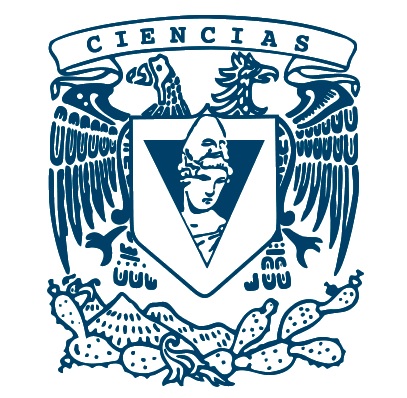
Máximos y Mínimos de Funciones de Varias Variables
Angel Carrillo Hoyo, Elena de Oteyza de Oteyza\(^2\), Carlos Hernández Garciadiego\(^1\), Emma Lam Osnaya\(^2\)

 |
Máximos y Mínimos de Funciones de Varias VariablesAngel Carrillo Hoyo, Elena de Oteyza de Oteyza\(^2\), Carlos Hernández Garciadiego\(^1\), Emma Lam Osnaya\(^2\) |  |
Solución:
La función es \begin{equation*} f\left( x,y,z\right) =z. \end{equation*} Las restricciones son \begin{eqnarray*} g_{1}\left( x,y,z\right) & = & z^{3}-x^{2}=0 \\ g_{2}\left( x,y,z\right) & = & z^{3}-y^{2}=0. \end{eqnarray*} La intersección de estas superficies es \begin{equation*} S=\left\{ \left. \left( x,y,z\right) \in \mathbb{R}^{3}\,\right\vert \,z^{3}-x^{2}=0 \quad \text{y} \quad z^{3}-y^{2}=0\right\} . \end{equation*} Si \(\left( x,y,z\right) \in S\) entonces \begin{equation*} z^{3}-x^{2}=z^{3}-y^{2}, \end{equation*} de donde, \begin{equation*} x^{2}=y^{2} \end{equation*} así, \begin{equation*} y=x \quad \quad \quad \text{o} \quad \quad \quad y=-x. \end{equation*} Entonces los puntos \begin{equation*} \left( x,y,z\right) =\left( x,x,\sqrt[3]{x^{2}}\right) \quad \quad \quad \text{o} \quad \quad \quad \left( x,y,z\right) =\left( x,-x,\sqrt[3]{x^{2}} \right) . \end{equation*} están en la intersección.
Recíprocamente, si \(\left( x,y,z\right) \) es de alguno de estos dos tipos entonces \(\left( x,y,z\right) \in S.\) Así, \begin{equation*} S=\left\{ \left. \left( x,x,\sqrt[3]{x^{2}}\right) \right\vert \,x\in \mathbb{R}\right\} \bigcup \left\{ \left. \left( x,-x,\sqrt[3]{x^{2}}\right) \right\vert \,x\in \mathbb{R}\right\} . \end{equation*} Entonces, \(\left( 0,0,0\right) \in S\) y \begin{eqnarray*} f\left( x,x,\sqrt[3]{x^{2}}\right) & = & \sqrt[3]{x^{2}}>0=f\left( 0,0,0\right) \text{ si }x\neq 0 \\ f\left( x,-x,\sqrt[3]{x^{2}}\right) & = & \sqrt[3]{x^{2}}>0=f\left( 0,0,0\right) \text{ si }x\neq 0. \end{eqnarray*} Por tanto, \(\left. f\right\vert _{S}\) tiene un mínimo absoluto estricto en \(\left( 0,0,0\right) .\) No hay ningún otro punto mínimo ni máximo.
El punto \(\left( 0,0,0\right) \) no se obtiene como candidato para que \(\left. f\right\vert _{S}\) tenga en él un valor extremo a través del método de Lagrange, como ahora veremos.
Tenemos que resolver el sistema \begin{eqnarray*} \nabla f & = & \lambda \nabla g_{1}+\mu \nabla g_{2}, \\ z^{3}-x^{2} & = & 0 \\ z^{3}-y^{2} & = & 0, \end{eqnarray*} es decir, \begin{eqnarray} 0 & = & -2x\lambda \notag \\ 0 & = & -2y\mu \notag \\ 1 & = & 3z^{2}\lambda +3z^{2}\mu =3\left( \lambda +\mu \right) z^{2} \label{ecu11m} \\ z^{3}-x^{2} & = & 0 \notag \\ z^{3}-y^{2} & = & 0. \notag \end{eqnarray} De la primera ecuación tenemos \begin{equation*} x\lambda =0, \end{equation*} de donde, \begin{equation*} x=0 \quad \quad \quad \text{o} \quad \quad \quad \lambda =0. \end{equation*}
Por tanto, el sistema de Lagrange no tiene solución (\ref{ecu11m}). Observamos que no se cumple que los gradientes de \(g_{1}\left( x,y,z\right) \) y \(g_{2}\left( x,y,z\right) \) en \(\left( 0,0,0\right) \) sean linealmente independientes, ya que \begin{eqnarray*} \nabla g_{1}\left( x,y,z\right) & = & \left( -2x,0,3z^{2}\right) ; \quad \quad \quad \nabla g_{1}\left( 0,0,0\right) =\left( 0,0,0\right) \\ \nabla g_{2}\left( x,y,z\right) & = & \left( 0,-2y,3z^{2}\right) ; \quad \quad \quad \nabla g_{2}\left( 0,0,0\right) =\left( 0,0,0\right) . \end{eqnarray*}